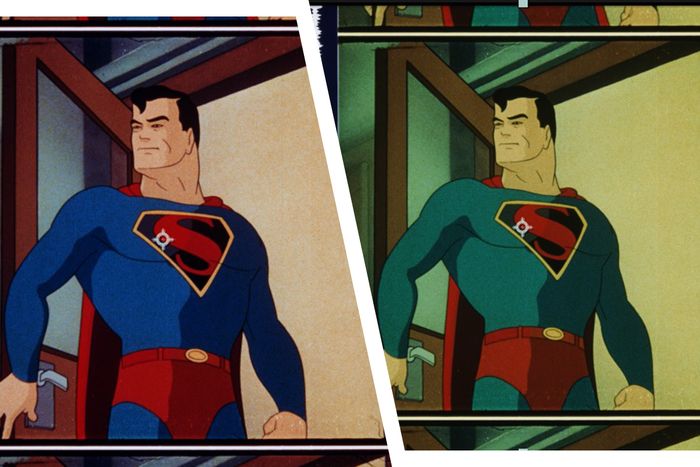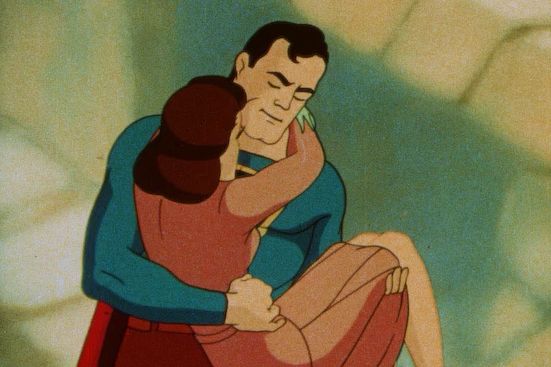
This weekend, Superman flies off the small screen again as the second season of My Adventures With Superman, a show that filters the last son of Krypton through the lens of romantic comedy, wraps up. My Adventures works in part because, despite an anime-inspired art style, it never strays too far from the core aesthetics of the Man of Steel. The show’s animators have paid homage to the character’s long history in animation, but none of their nods are as eye-catching as their tributes to the classic Superman film shorts that began in 1941.
Those shorts produced by Max Fleischer and directed by his brother Dave were Superman’s first adventures on the big screen, or any screen at all. The ’40s series is the reason you think of “faster than a speeding bullet!” when you think of the Man of Steel and also where he first learned to fly (not just jump good). They were made just a few years after the character debuted in Jerry Seigel and Joe Shuster’s Action Comics #1, and influenced not just his iconography but definitive portrayals of other characters, like Batman: The Animated Series. A producer of that show, Bruce Timm, who later made a Superman show of his own, once called the Fleischer shorts “where the bar is set” for animated Superman: “That’s the level you’re never gonna hit.”
Today, the shorts are the stuff of animation legend, despite a fractured production, a chaotic afterlife in the public domain, and multiple re-releases, including a new restoration led by the Fleischer family. The serial straddled two shops — the first nine shorts were produced by Fleischer Studios before Paramount acquired the studio and ousted its founders. Paramount then formed “Famous Studios,” with Seymour Keitel, a long-time head animator for Fleischer, taking over after the “Terror on Midway” short. The eight Famous shorts that followed are punnier and somewhat stolid compared to Fleischer’s, which were action-focused, light on dialogue, and in a class of their own.
The Fleischer Studios–produced shorts quickly established a fun formula. Each opens with the customary intro to the dichotomy of mild-mannered Clark Kent and the amazing stranger from the planet Krypton — Superman. Here he was raised in an orphanage, so no Ma and Pa Kent, nor most of his supporting cast or rogues gallery. Inevitably, a headline from Lois Lane announces an imminent threat. Clark declares it “a job for Superman,” slinks away to change, and stops it, give or take a few steps, before winking at the camera. (Notably, Lois never feels like a helpless damsel; in one episode she picks up a tommy gun and fires back at the criminal gunmen.) Rewatching the shorts back to back, that structure feels satisfyingly rhythmic, a canvas for creative ways to visualize Superman’s fantastic powers. Audiences in the ’40s would have watched the shorts at the cinema, and their familiarity helped push Superman toward ubiquity.
They’re also masterful on a technical level. Fleischers’ Superman showcased a departure from the broader, rubber-limbed cartoonishness of their earlier characters like Koko the Clown, Popeye, and Betty Boop, which were achieved by pioneering animation techniques like rotoscoping. Superman felt like a step further, with the realistic weight of its movement, and the feeling that its animation was bound to the physics of the real world, which made the character’s impossible feats feel even more fantastic.
Despite their myriad pleasures, two big caveats come with watching the ’40s Superman today. First, like many cartoons of its era, it indulges in racist caricature and propaganda. In “Electric Earthquake,” the mad scientist of the month is a Native American who dares to suggest that Manhattan (not Metropolis!) exists on stolen land. He’s deemed a crank by Perry White, not long before kidnapping Lois. Installments from Famous Studios go further, with the wartime propaganda of “Japoteurs” and “Eleventh Hour.” Even when Superman fights the Nazis, it comes with a side of anti-Blackness: The African setting in “Jungle Drums” is exactly what you’d expect from the title. As an immigrant allegory himself, xenophobia feels incredibly strange on Superman. And with all of the dry talkiness of the Famous shorts, it’s also hard not to miss the uncomplicated joys of the Fleischer-produced first half, like Superman fighting a volcano or a fleet of robots.
The second caveat is that while the series as a whole is in the public domain, you’ll want to be choosy about which version you watch. The shorts are available for free on the Internet Archive, YouTube, and elsewhere, but their video and audio fidelity are a mixed bag. One Blu-ray to avoid at all costs was released by Gaiam, a controversial media company that overlaid shameless watermarks on top of the shorts. A recently restored edition from Warner Bros. exists on Max and on Blu-ray, produced from a scan of the films’ original Technicolor negatives, which WB controls. As of this writing, this is the sharpest version available, but fans are mixed on the WB restoration. One review declares that the scans were aggressively scrubbed, “robbing Max Fleischer’s Superman of its original texture.”
This concern spurred yet another restoration supervised by Max Fleischer’s granddaughter, Jane Fleischer Reid. She and collaborator Mauricio Alvarado were already looking for prints to source a restoration before the WB’s was announced, and the criticism of that release served as an added motivator. “Frankly, we thought if they did it, then great, we don’t need to touch it,” Alvarado says. “But once we started hearing that feedback, we thought we should take another look — to keep that grain in there, keep all those touches that make these films really special.”
The Fleischer team debuted their 4K restoration of “The Mechanical Monsters” at the Museum of Modern Art earlier this year. For now, no wide home release of the newly restored shorts has been announced; the best place to watch them is at one of Fleischer’s screenings. The project isn’t limited to Superman, either. “My grandfather made just short of 700 cartoons,” Fleischer Reid says. “We’ve got about 80 restored at this point, so I don’t know if we’ll get to all 700, but we will get at least another 80 to 100 done in the next year or two.” Of the Superman shorts, Alvarado notes that they are missing just a couple to complete the Fleischer Studios–produced block; they have no plans to restore the Famous shorts, in part due to the problematic content but mostly because they don’t fall under Fleischer’s umbrella.
While the second half of the shorts feel like relics, the first nine set a new animation standard. They’re pulpy, silly, and made with straightforwardness, realism, and idealism, no matter how you experience them. Their influence has reached every new interpretation of the character since, from My Adventures and the upcoming film by James Gunn to the anime My Hero Academia, which recently used the “faster than a speeding bullet” line. Even without the 80-plus years of lore and myth developed since, the astonishing craft of Fleischer’s Superman reminds us how at home he feels in animation — the medium that first unbound him from the laws of gravity.


